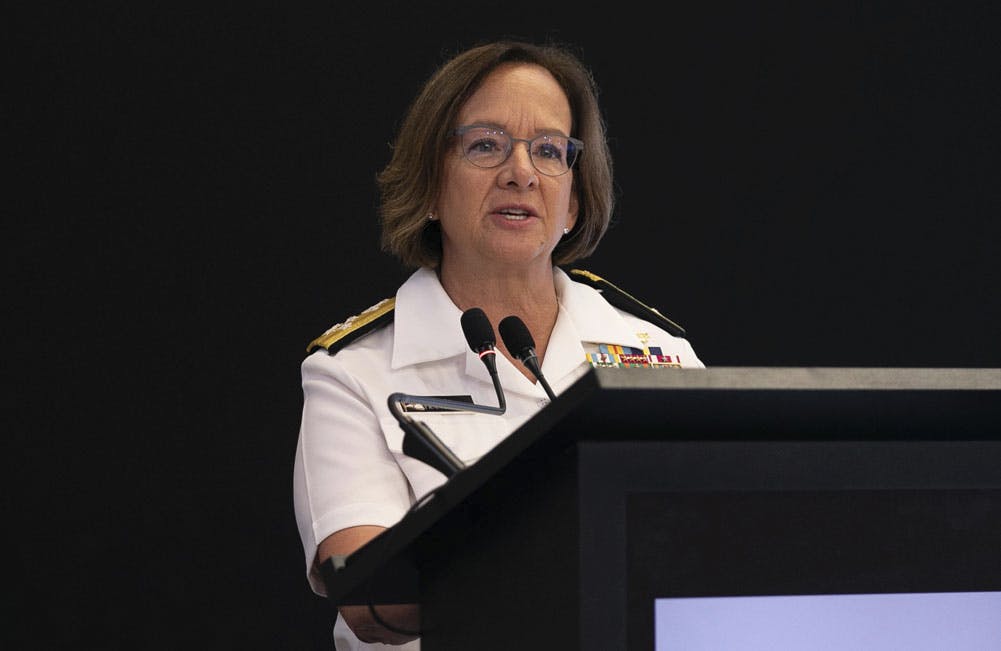Navy Chief Points to More Autonomous Systems, Robotics by 2027
Adm. Lisa Franchetti’s new plan prioritizes development of autonomous systems to prepare the Navy for growing aggression from China.

The Navy’s top officer sees growing use of autonomous and robotic systems as key parts of her navigation plan to prepare the service for adversarial threats from China over the next two years.
“There are things you can do in robotic and autonomous systems to be able to expand on the lethality and the depth of our conventional platforms,” said Chief of Naval Operations Adm. Lisa Franchetti at a Defense Writers Group meeting Wednesday.
The comments come amid Franchetti’s new navigation plan that sets strategic guidance for the Navy to outpace China. Outlined in that plan is a goal to operationalize robotic and autonomous systems, one of seven priority areas she calls “Project 33.”
“It’s pretty clear that, based on what [China President Xi Jinping] has said, his military forces need to be ready by 2027 for war,” she said. “My objective in the navigation plan is to make sure that we are, going forward, fully able to integrate the man-unmanned teaming concepts through these platforms, whether it’s under the sea, on the sea or above the sea.”
Franchetti during her tenure has consistently emphasized technology’s role in her priorities to counter threats from China as it grows its military force. Earlier this year, she noted that the size of the force alone is not an end point.
“It’s not about numbers. It’s about how you put it all together. It’s platforms on, under and above the sea,” she said in February. “It’s the networks that enable them. It’s cyber. It’s our work in space. It’s work with all the joint force. They are incredible force multipliers.”
Technology Advancements for the Joint Force
The Navy’s contribution to the joint warfighting effort is a key component of Franchetti’s navigation plan.
“When I talk about the joint warfighting ecosystem, just from a global perspective, the idea is that we have a ‘system of systems’ conversation,” said Franchetti. “You have a warfighting ecosystem enabled by the information warfare domain, space and cyber.”
The Navy is learning from activity around the world in accordance with Project 33’s goals, she said.
“We can analyze the engagements that we’re seeing in the Red Sea, and we can take the data that our weapon systems are seeing,” said Franchetti. “We can take that back here in the U.S., and we can let our engineers work with our people that develop tactics and procedures and work with industry to look at what is the adversary doing.”
“I talked a lot about in the nav plan, about the changing character of war,” she added. “Ukraine has shown us that you can innovate on the battlefield. I want to innovate before the battlefield.”
The Navy collaborates with other Defense Department components and industry partners on development of unmanned systems, Franchetti said. The service created the Disruptive Capabilities Office in 2023 to support the Pentagon’s Replicator plan, which is looking to maximize existing unmanned weapons, systems and vehicles across the department.
“We stood up our Disruptive Capabilities Office … to take and find technology that’s already out there and ripe and ready to go and ready to be integrated,” said Franchetti. “What we really want to do is understand what the fleets need and then we can help get after those capabilities more effectively. “
This is a carousel with manually rotating slides. Use Next and Previous buttons to navigate or jump to a slide with the slide dots
-

AI Foundations Driving Government Efficiency
Federal agencies are modernizing systems, managing risk and building trust to scale responsible AI and drive government efficiency.
40m watch -

Navy Memo Maps Tech Priorities for the Future Fight
Acting CTO’s memo outlines critical investment areas, from AI and quantum to cyber and space, as part of an accelerated modernization push.
5m read -

DOD Can No Longer Assume Superiority in Digital Warfare, Officials Warn
The DOD must make concerted efforts to address cyber vulnerabilities to maintain the tactical edge, military leaders said at HammerCon 2025.
4m read -

New NSF Program Cultivates the Future of NextG Networks
The agency’s new VINES program looks to tackle key challenges like energy efficiency and future-proofing wireless tech.
21m watch -

DHA CDAO Spearheads Master Data Catalog to Boost Transparency
Jesus Caban plans to boost DHA's data maturity through a new master data catalog, governance frameworks and inventory of tech tools.
5m read -

Trump Orders Spark Government-Wide Acquisition Overhaul
As Trump pushes for a faster, simpler procurement system, agencies are leveraging AI and adapting strategies to meet new requirements.
5m read -

IRS Makes Direct File Code Public as Lawmakers Debate Program’s Fate
The agency sees the Direct File source code as beneficial to government digital services despite what happens with it in proposed budgets.
5m read -

Inside Oak Ridge National Lab’s Pioneer Approach to AI
Energy Department’s Oak Ridge National Lab transforms AI vulnerabilities into strategic opportunities for national defense.
22m listen -

A Look at Federal Zero Trust Transformation
Recent developments from CISA and DOD show how government is advancing zero trust quickly.
20m read -

Modernization Strategies to Enable Energy Innovation
Lawrence Berkeley National Lab and Maximus experts explore the modernization strategies driving digital transformation and operational resilience within the energy sector.
33m watch -

DOI Must Modernize Energy to Win AI Race, Secretary Says
Doug Burgum links AI innovation to energy reform as DOI advances digital infrastructure and wildfire response under Trump’s tech agenda.
2m read -

NIST to Release New AI Cybersecurity Guidance as Federal Use Expands
NIST plans to release AI cybersecurity guidance within the year to support safe adoption as federal agencies expand use cases.
4m read
















